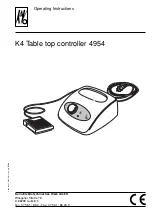
DMX 512 CONTROLLER SERIES
2.5 Common Terms
2.5 Common Terms
The following are common terms used in intelligent light programming.
is a state by where all lighting fixtures light output are set to 0 or off, usually on a temporary
basis.
is an industry standard digital communication protocol used in entertainment lighting
equipment. For more information read Sections
DMX Primer
and
DMX Control Mode
in the
Appendix.
refers to your lighting instrument or other device such as a fogger or dimmer of which you can
control.
are a bunch of scenes stacked one after another. It can be programmed as either a single
scene or multiple scenes in sequence.
are static lighting states.
also known as faders.
can also be called programs. A chase consists of a bunch of scenes stacked one after
another.
refers to a lighting instrument with a pan and tilt mirror; however, in the ILS-CON controller it
can be used to control any DMX-512 compatible device as a generic fixture.
is a standard for representing musical information in a digital format. A MIDI input would provide
external triggering of scenes using midi device such as a midi keyboard.
refers to a fixture
s ability to function independently of an external controller and usually
in sync to music, due to a built in microphone.
slider is used to adjust the time between scenes within a chase.
slider affects the amount of time a scene will hold its state. It is also considered a wait time.
is a mechanical device in the lighting fixture that allows you to block the lights path. It is often
used to lessen the intensity of the light output and to strobe.
refers to the process of assigning fixtures a DMX channel or.
can be either scenes or chases that are directly called to execution by the user. A playback
can also be considered program memory that can be recalled during a show.
Blackout
DMX-512
Fixture
Programs
Scenes
Sliders
Chases
Scanner
MIDI
Stand Alone
Fade
Speed
Shutter
Patching
Playbacks
3.OPERATING INSTRUCTIONS
3.OPERATING INSTRUCTIONS
3.1 Setup
3.1.1 SETTING UP THE SYSTEM
1)
Plug the AC to DC power supply to the system back panel and to the mains outlet.
2) Plug in your DMX cable(s) to your intelligent lighting as described in the fixtures respective
manual. For a quick Primer on DMX see the DMX Primer section in the Appendix of this
manual.
“
”
USER MANUAL
6/18





































